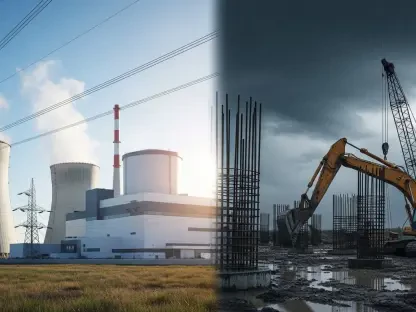In a rapidly changing global energy landscape, Asia faces a complex challenge of balancing traditional coal reliance with the emerging demands for renewable energy transition. Despite the undeniable economic allure of coal, the region’s attachment to this conventional power source creates a fascinating narrative of contrasts. National security concerns, coupled with significant economic considerations, have tethered Asian nations to coal, even as cheaper and more sustainable hybrid solar and storage solutions become increasingly viable alternatives. However, the mounting pressure to reduce carbon emissions and adhere to international climate commitments casts a significant shadow over coal’s future viability. This complex scenario highlights the intricate dynamics at play as Asia navigates a path entwined between legacy energy dependencies and the imperative of a greener future. Understanding this balancing act is crucial, as it carries profound implications not only for Asia but also for global energy policies and environmental outcomes.
The Economic and Political Underpinnings
Asia’s continued reliance on coal is deeply intertwined with its political and economic landscape, presenting a formidable challenge to shift toward cleaner energy sources. Despite the declining cost of renewable technologies, the affordability and availability of coal sustain its appeal for many Asian countries. Coal’s persistent economic advantage over gas-fired power generation keeps it in play, especially with the levelized cost of unabated coal power expected to remain competitive in the Asia and Pacific region. With estimates projecting these costs to stay below $100 per MWh by 2030, coal’s relative affordability in Asia contrasts starkly with Western markets, where expenses are significantly higher. This economic disparity leads to broader geopolitical implications. Governments often prioritize energy security and economic stability over environmental concerns, resulting in policies that continue to favor coal. National interests, therefore, become a critical driver in determining energy strategies, complicating the global push toward reducing carbon emissions and adopting renewable energy solutions.
Political factors also play a pivotal role in Asia’s energy decisions, with national security at the forefront of coal dependency. Countries prioritize energy independence, often viewing coal as a dependable and domestically available resource. This emphasis on resource availability further reinforces coal’s position, despite growing awareness of its environmental impacts. Additionally, the prospect of significant disruptions due to transitioning from well-established coal infrastructure to renewable systems poses challenges many Asian nations are not yet equipped to address. The economic ripple effects of such transitions, including employment and industry shifts, weigh heavily on decision-makers. This intricate blend of economic benefit and political necessity makes transitioning from coal particularly challenging, necessitating nuanced strategies that accommodate the unique needs and conditions of different Asian nations. As these dynamics unfold, understanding the deep-seated factors that underpin coal reliance helps frame the conversation around Asia’s energy future.
Implications for Global Energy Dynamics
Exploring Asia’s coal dilemma reveals broader implications for global energy dynamics, underscoring the intricate interplay between regional practices and worldwide environmental goals. The potential for extended reliance on coal in Asia suggests significant consequences for global carbon emissions, posing a threat to climate targets such as those outlined in the Paris Agreement. According to projections, if current trends continue, coal could displace substantial renewable and gas power capacities by 2050, posing a formidable challenge to international efforts aimed at mitigating climate change. Recognizing this stark reality, Asian governments and industries face mounting pressure to reconsider their energy trajectories. Balancing energy security with sustainability emerges as a pivotal task, necessitating policies that encourage investment in cleaner alternatives while addressing the socio-economic impacts of a renewable transition. Embracing strategies such as incentivizing renewable development and investing in technologies like carbon capture could mitigate the environmental repercussions of coal dependency.
Technology and innovation also emerge as key drivers in reshaping Asia’s energy landscape, offering promising avenues to alleviate reliance on coal. Integration of advanced energy storage solutions, alongside advancements in solar and wind technologies, could transform the viability of renewable energy for many Asian countries. However, challenges remain, including the need for technological maturation and cost adjustments to facilitate widespread adoption. Bridging these gaps requires focused collaboration between governments, industries, and research institutions, aiming to create an ecosystem that supports technological advancements and economic feasibility. Effectively navigating these complexities will be crucial for Asia’s transition from coal and ensuring alignment with global environmental objectives. This complex web of factors, encompassing economic, political, and technological dimensions, presents a nuanced picture of Asia’s coal dilemma, underscoring the importance of strategic interventions to facilitate a successful energy transition.
Navigating the Path Forward
In the swiftly evolving global energy scene, Asia confronts the formidable task of balancing its reliance on coal with the pressing need for a renewable shift. Coal, with its undeniable economic appeal, has remained a cornerstone for many Asian nations. However, this reliance creates an intriguing juxtaposition in a world increasingly advocating for cleaner energy solutions. Factors such as national security and economic interests continue to bind these countries to coal, despite the growing feasibility and affordability of hybrid solar and storage options. Still, the rising pressure to decrease carbon emissions and fulfill international climate pledges challenges coal’s long-term viability. This scenario underscores the intricate dynamics Asia faces, as it threads the needle between historical energy dependencies and the necessity for sustainable, eco-friendly alternatives. Grasping this delicate balance is vital, as its impact reaches beyond Asia, influencing global energy strategies and environmental directions.









